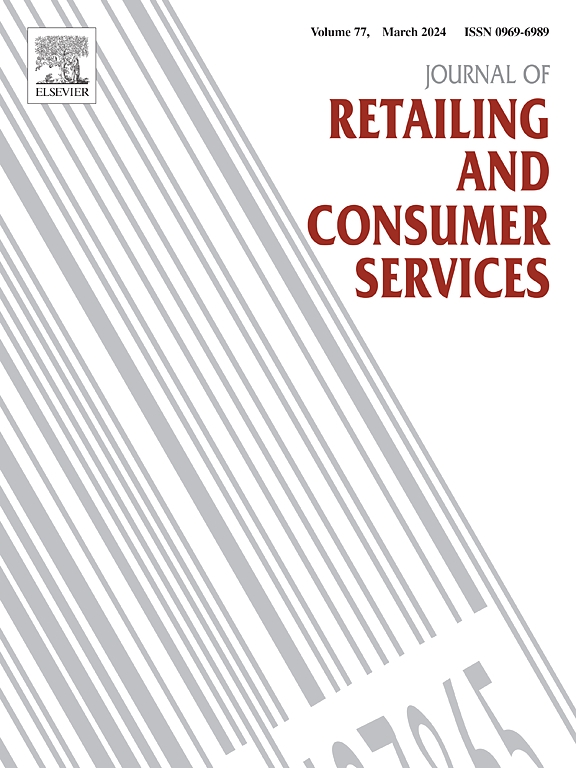Factors impeding buy now, pay later (BNPL) adoption in India: A mixed-method approach
IF 11
1区 管理学
Q1 BUSINESS
Journal of Retailing and Consumer Services
Pub Date : 2025-07-01
DOI:10.1016/j.jretconser.2025.104402
引用次数: 0
Abstract
Buy Now, Pay Later (BNPL) services are reshaping digital credit access in India, yet their adoption remains limited due to complex and interrelated consumer barriers. While previous research has explored general fintech or digital payment adoption, there is a significant gap in understanding BNPL-specific barriers, particularly how these barriers influence one another within India’s distinct socio-economic and regulatory landscape. India’s rapid fintech growth, large unbanked population, evolving regulatory environment, and uneven levels of digital and financial literacy make it a unique and urgent case for such inquiry. Thus, this study aims to identify and rank the key barriers to BNPL adoption in the Indian context and analyze their causal interrelationships, and adopts a sequential mixed-methods design for the same. In the qualitative phase, a netnographic analysis of BNPL app reviews—supported by existing literature (specifically Innovation Resistance Theory) and expert insights—was used to identify barriers. In the quantitative phase, the ‘Decision-Making Trial and Evaluation Laboratory’ (DEMATEL) method was employed to analyze seven identified barriers, categorize them into causal and effect groups, and assess their interdependencies. The findings reveal digital illiteracy as the most influential causal barrier, affecting others such as inertia, privacy concerns, hidden fees and high penalty fees, and negative credit profiles. Impulse buying and regulatory concerns also emerged as key causal factors. The study offers practical recommendations, such as financial education, responsible lending, and regulatory reform, and contributes to BNPL literature by applying a novel methodological lens to an underexplored market. These insights can guide stakeholders seeking to responsibly scale BNPL adoption in India.
阻碍印度采用“先买后付”(BNPL)的因素:混合方法
先买后付(BNPL)服务正在重塑印度的数字信贷渠道,但由于复杂且相互关联的消费者障碍,它们的采用仍然有限。虽然之前的研究已经探索了一般金融科技或数字支付的采用,但在理解bnpl特定障碍方面存在重大差距,特别是这些障碍如何在印度独特的社会经济和监管环境中相互影响。印度金融科技的快速发展、大量无银行账户的人口、不断变化的监管环境以及数字和金融知识水平的不平衡,使其成为进行此类调查的独特而紧迫的案例。因此,本研究旨在识别和排名印度环境下采用BNPL的主要障碍,并分析其因果关系,并采用顺序混合方法设计。在定性阶段,利用现有文献(特别是创新阻力理论)和专家见解支持的BNPL应用程序评论的网络分析来识别障碍。在定量阶段,采用“决策试验和评估实验室”(DEMATEL)方法对七个已确定的障碍进行分析,将其分类为因果组和效果组,并评估其相互依赖性。调查结果显示,数字文盲是最具影响力的因果障碍,影响着惰性、隐私担忧、隐性费用和高额罚款以及负面信用档案等其他障碍。冲动购买和监管方面的担忧也是关键的原因。该研究提出了一些实用的建议,如金融教育、负责任的贷款和监管改革,并通过将一种新的方法论视角应用于一个未被充分开发的市场,为BNPL文献做出了贡献。这些见解可以指导利益相关者在印度负责任地扩大BNPL的采用。
本文章由计算机程序翻译,如有差异,请以英文原文为准。
求助全文
约1分钟内获得全文
求助全文
来源期刊
CiteScore
20.40
自引率
14.40%
发文量
340
审稿时长
20 days
期刊介绍:
The Journal of Retailing and Consumer Services is a prominent publication that serves as a platform for international and interdisciplinary research and discussions in the constantly evolving fields of retailing and services studies. With a specific emphasis on consumer behavior and policy and managerial decisions, the journal aims to foster contributions from academics encompassing diverse disciplines. The primary areas covered by the journal are:
Retailing and the sale of goods
The provision of consumer services, including transportation, tourism, and leisure.

 求助内容:
求助内容: 应助结果提醒方式:
应助结果提醒方式:


